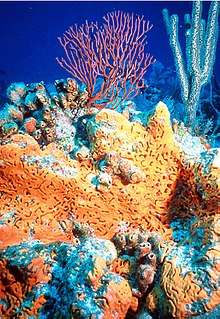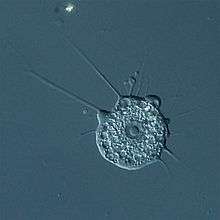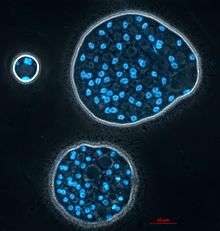Filozoa
| Filozoans | |
|---|---|
 | |
| Orange elephant ear sponge, Agelas clathrodes, in foreground. Two corals in the background: a sea fan, Iciligorgia schrammi, and a sea rod, Plexaurella nutans. | |
| Scientific classification | |
| (unranked): | Unikonta |
| (unranked): | Obazoa |
| (unranked): | Opisthokonta |
| (unranked): | Holozoa |
| (unranked): | Filozoa Shalchian-Tabrizi et al., 2008 |
| Subgroups | |
The Filozoa are a monophyletic grouping within the Opisthokonta. They include animals and their nearest unicellular relatives (those organisms which are more closely related to animals than to fungi or Mesomycetozoa).[1]
Three groups are currently assigned to the clade Filozoa:
- Group Filasterea - recently erected to house the genera Ministeria and Capsaspora
- Group Choanoflagellatea - collared flagellates
- Kingdom Animalia - the animals proper
Etymology
From Latin filum meaning "thread" and Greek zōion meaning "animal".
Phylogeny
| Opisthokonta |
| ||||||||||||||||||||||||||||||||||||||||||||||||||||||||||||||||||
Characteristics
The ancestral opisthokont cell is assumed to have possessed slender filose (thread-like) projections or 'tentacles'. In some opisthokonts (Mesomycetozoa and Corallochytrium) these were lost. They are retained in Filozoa, where they are simple and non-tapering, with a rigid core of actin bundles (contrasting with the flexible, tapering and branched filopodia of nucleariids and the branched rhizoids and hyphae of fungi). In choanoflagellates and in the most primitive animals, namely sponges, they aggregate into a filter-feeding collar around the cilium or flagellum; this is thought to be an inheritance from their most recent common filozoan ancestor.[1]
References
- 1 2 Shalchian-Tabrizi K.; Minge M.A.; Espelund M.; et al. (7 May 2008). Aramayo, Rodolfo, ed. "Multigene phylogeny of choanozoa and the origin of animals". PLoS ONE. 3 (5): e2098. doi:10.1371/journal.pone.0002098. PMC 2346548. PMID 18461162.

- ↑ Parfrey, Laura Wegener; Lahr, Daniel J. G.; Knoll, Andrew H.; Katz, Laura A. (16 August 2011). "Estimating the timing of early eukaryotic diversification with multigene molecular clocks". Proceedings of the National Academy of Sciences. 108 (33): 13624–13629. doi:10.1073/pnas.1110633108. ISSN 0027-8424. PMC 3158185. PMID 21810989.
- ↑ Hehenberger, Elisabeth; Tikhonenkov, Denis V.; Kolisko, Martin; Campo, Javier del; Esaulov, Anton S.; Mylnikov, Alexander P.; Keeling, Patrick J. (10 July 2017). "Novel Predators Reshape Holozoan Phylogeny and Reveal the Presence of a Two-Component Signaling System in the Ancestor of Animals". Current Biology. 27 (13): 2043–2050.e6. doi:10.1016/j.cub.2017.06.006. PMID 28648822.

